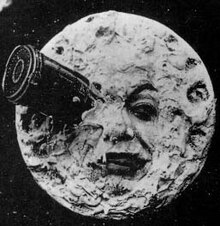
Back رحلة إلى القمر (فيلم فرنسي) Arabic Aya səyahət (film, 1902) Azerbaijani Падарожжа на месяц (фільм, 1902) Byelorussian Пътешествие до луната Bulgarian Le Voyage dans la Lune Catalan Cesta na Měsíc Czech Уйӑх ҫине ҫӳрени CV Le Voyage dans la Lune Welsh Rejsen til månen (film) Danish Die Reise zum Mond German
| A Trip to the Moon | |
|---|---|
 The landing on the eye of the Moon, the movie's most iconic scene | |
| Directed by | Georges Méliès |
| Written by | Georges Méliès |
| Produced by | Georges Méliès |
| Starring |
|
| Cinematography |
|
| Edited by | Georges Méliès |
Production company | |
Release date |
|
Running time | |
| Country | France |
| Language | Silent |
| Budget | ₣10,000 |
A Trip to the Moon (French: Le voyage dans la lune)[a] is a 1902 French science-fiction adventure trick film directed by Georges Méliès. Inspired by Jules Verne's 1865 novel From the Earth to the Moon and its 1870 sequel Around the Moon, the film follows a group of astronomers who travel to the moon in a cannon-propelled capsule, explore the moon's surface, escape from an underground group of Selenites (lunar inhabitants), and return to earth with a captive Selenite. Méliès leads an ensemble cast of French theatrical performers as the main character Professor Barbenfouillis.
Although the film disappeared into obscurity after Méliès's retirement from the film industry, it was rediscovered around 1930, when Méliès's importance to the history of cinema was beginning to be recognised by film devotees. An original hand-colored print was discovered in 1993 and restored in 2011.
A Trip to the Moon was ranked 84th of the 100 greatest films of the 20th century by The Village Voice.[6] The film remains Méliès' best known, and the moment in which the capsule lands in the moon's eye remains one of the most iconic and frequently referenced images in the history of cinema.
- ^ Cite error: The named reference
Technicolor186was invoked but never defined (see the help page). - ^ a b c Hammond, Paul (1974), Marvellous Méliès, London: Gordon Fraser, p. 141, ISBN 0-900406-38-0
- ^ a b c d Frame rate calculations produced using the following formula: 845 feet / ((n frame/s * 60 seconds) / 16 frames per foot) = x. See Elkins, David E. (2013), "Tables & Formulas: Feet Per Minute for 35 mm, 4-perf Format", The Camera Assistant Manual Web Site (companion site for The Camera Assistant's Manual [Burlington, MA: Focal Press, 2013]), retrieved 8 August 2013.
- ^ a b Cite error: The named reference
EzraSatirewas invoked but never defined (see the help page). - ^ a b Malthête & Mannoni 2008, p. 344
- ^ Village Voice Critics' Poll (2001), "100 Best Films", filmsite.org, AMC, archived from the original on 13 June 2016, retrieved 2 August 2013
Cite error: There are <ref group=lower-alpha> tags or {{efn}} templates on this page, but the references will not show without a {{reflist|group=lower-alpha}} template or {{notelist}} template (see the help page).
© MMXXIII Rich X Search. We shall prevail. All rights reserved. Rich X Search